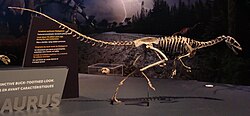| Masiakasaurus Temporal range: Late Cretaceous (Maastrichtian)
| |
|---|---|

| |
| Reconstructed skeleton, Royal Ontario Museum, Toronto, Canada | |
| Scientific classification | |
| Domain: | Eukaryota |
| Kingdom: | Animalia |
| Phylum: | Chordata |
| Clade: | Dinosauria |
| Clade: | Saurischia |
| Clade: | Theropoda |
| Clade: | †Abelisauria |
| Family: | †Noasauridae |
| Subfamily: | †Noasaurinae |
| Genus: | †Masiakasaurus Sampson et al., 2001 |
| Species: | †M. knopfleri
|
| Binomial name | |
| †Masiakasaurus knopfleri Sampson et al., 2001
| |
Masiakasaurus is a genus of small predatory noasaurid theropod dinosaurs from the Late Cretaceous of Madagascar. In Malagasy, masiaka means "vicious"; thus, the genus name means "vicious lizard". The type species, Masiakasaurus knopfleri, was named after the musician Mark Knopfler, whose music inspired the expedition crew. It was named in 2001 by Scott D. Sampson, Matthew Carrano, and Catherine A. Forster. Unlike most theropods, the front teeth of M. knopfleri projected forward instead of straight down. This unique dentition suggests that they had a specialized diet, perhaps including fish and other small prey. Other bones of the skeleton indicate that Masiakasaurus were bipedal, with much shorter forelimbs than hindlimbs. M. knopfleri was a small theropod, reaching 1.8–2.1 m (5.9–6.9 ft) long and weighing 20 kg (44 lb).[1][2][3]
Masiakasaurus lived from 72.1 to 66 million years ago, along with animals such as Majungasaurus, Rapetosaurus, and Rahonavis. Masiakasaurus was a member of the group Noasauridae, small predatory ceratosaurs found primarily in South America.
- ^ Cite error: The named reference
SCF01was invoked but never defined (see the help page). - ^ Grillo, O. N.; Delcourt, R. (2016). "Allometry and body length of abelisauroid theropods: Pycnonemosaurus nevesi is the new king". Cretaceous Research. 69: 71–89. doi:10.1016/j.cretres.2016.09.001.
- ^ Paul, Gregory S. (2010). The Princeton Field Guide to Dinosaurs. New Jersey: Princeton University Press. pp. 82. ISBN 9780691137209.